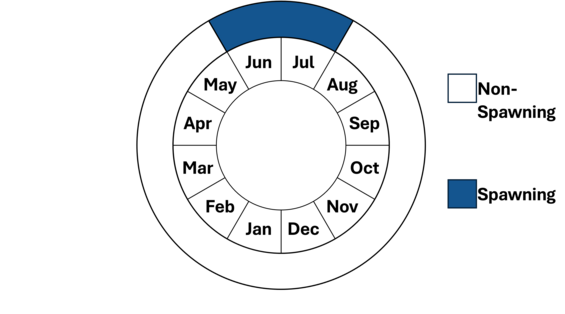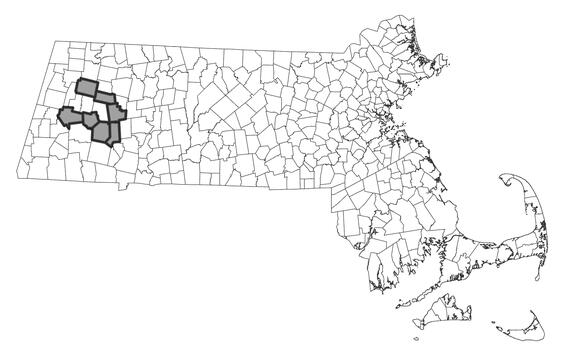- Scientific name: Couesius plumbeus
- Species of Greatest Conservation Need (MA State Wildlife Action Plan)
- Endangered (MA Endangered Species Act)
Description
Lake chub (Couesius plumbeus)
The lake chub is an elongate, round-bodied minnow with a small but well-developed thread-like barbel at the posterior end of the upper jaw. They are generally 100 mm but can reach up to 150 mm (5.9 in) in length. The lake chub has a large eye and a bluntly rounded snout which slightly overhangs the mouth and is completely separated from the upper lip by a continuous deep groove. The lake chub is colored dark, greenish-gray or dark brown on the back, becoming silvery-gray on the sides and whitish on the belly. A midlateral stripe is most prominent in juveniles. The scales are small and are usually crowded anteriorly. Their dorsal fin has 8 rays and the anal fin has 7 or 8 rays. During breeding season males develop patches of red around the mouth and at the bases of the pectoral and pelvic fins. Both sexes can develop tubercles (small, pimple-like bumps) around the head, breast, and pectoral and pelvic fins.
The blacknose dace (Rhinichthys atratulus) and creek chub (Semotilus atromaculatus) both have similar body shapes and barbels on the mouth. In the blacknose dace the upper lip is joined to the tip of the snout by a bridge of tissue, whereas the lake chub has a continuous deep groove around the lip. The barbel on the creek chub is located in the groove above the lip and is often hard to see. They also have a dark spot at the base of their dorsal fin, which lake chubs do not.
Life cycle and behavior

Few studies have investigated the life history of lake chubs, and those available generally pertain to lake populations. Triggered by water temperature, lake chubs spawn in spring and early summer, and lake populations often move into streams and may migrate large distances. Lake chubs appear to be most active at dawn and dusk compared to during the day. River populations may also move large distances during the spawning season, possibly up to 10 km (6.2 mi). Lake chub also migrate back to lakes or deeper river habitat in the fall months. This species does not build a nest but deposits sinking eggs on gravel or sand substrates. Lake chubs mature in their third or fourth year and seldom live beyond five years. They feed on zooplankton, aquatic insects, algae, and small fishes.
Population status
The lake chub is listed as endangered in Massachusetts. As with all species listed in Massachusetts, individuals of the species are protected from take (picking, collecting, killing, etc.) and sale under the Massachusetts Endangered Species Act.
Distribution and abundance
The lake chub range extends from Alaska west throughout Canada and as far south Colorado, Illinois, Indiana, New York, and Massachusetts. In New England, the species occurs in Massachusetts, Vermont, New Hampshire, and Maine. In Massachusetts, the species occurs only in the Westfield River watershed representing the southernmost range extent in New England and may be considered a glacial relict. Further, this population is functionally disjunct or isolated from populations further north in the Connecticut River watershed in Vermont and New Hampshire. Lake chubs have been consistently observed in routine fish community surveys in the past 20 years in two branches of the Upper Westfield River confirming continued reproduction and persistence of this population. Connectivity between river branches is likely low or absent.
The lake chub is listed as endangered in Massachusetts. As with all species listed in Massachusetts, individuals of the species are protected from take (picking, collecting, killing, etc.) and sale under the Massachusetts Endangered Species Act.

Distribution in Massachusetts. 2000-2025. Based on records in the Natural Heritage Database.
Habitat
The lake chub is restricted to clear, cold lakes and clear, cold, fast-flowing rivers. They have only been found in medium-sized streams in Massachusetts. They seem to prefer areas with gravel or cobble substrates and little or no vegetation.
Healthy habitats are vital for supporting native wildlife and plants. Explore habitats and learn about conservation and restoration in Massachusetts.

School of lake chub staying close to boulder cover (left) and typical lake chub stream habitat in Massachusetts.
Threats
Threats to lake chub in Massachusetts include increased turbidity, erosion and sedimentation, flow alterations, chemical runoff (e.g., road salt), dispersal barriers, and extreme hydrologic events. Lake chubs are visual feeders, and increased turbidity can decrease their feeding efficiency. Erosion and sedimentation and flow alterations can degrade clean, gravel spawning substrates that are required for proper egg development. Barriers such as dams and undersized culverts likely limit dispersal and restrict connectivity within the watershed. Climate change may also impact lake chub through more extreme flooding, prolonged droughts and increased water temperatures.
Survey and monitoring
Lake chub is monitored through routine fish community surveys and are successful at detecting the species in its riverine habitat.
Management
Management for this species focuses on habitat protection and restoration such as improvements to streamflow, dam removal, culvert replacement, and riparian and streambank restoration. Protection of forested riparian zones and watersheds is critical for maintaining high water quality and cooler water temperatures.
Research needs
Effort is needed to establish long-term monitoring sites to detect temporal trends in population size, determine spawning sites and refine spawning date range, determine potential seasonal migration behavior, identify potential dispersal barriers, determine population genetic structure and variation among river branches to determine gene flow and compare with more northernly core populations, evaluation of critical swimming thresholds to inform dam and culvert design, and assess the species risk to climate change impacts including increased stream temperature and extreme flows.
References
Hartel, K.E., Halliwell, D.B., Launer, A.E. Inland Fishes of Massachusetts. Lincoln, MA: Massachusetts Audubon Society, 2002.
Reebs, S.G., L. Boudreau, P. Hardie, R.A. Cunjak. 1995. Diel activity patterns of lake chubs and other fishes in a temperate stream. Canadian Journal of Zoology 73:1221-1227.
Reebs, S., S. Leblanc, A. Fraser, P. Hardie, R.A. Cunjak. 2008. Upstream and downstream movements of lake chub, Couesius plubeus, and white sucker, Catostomus commersoni, at Catamaran Brook, 1990-2004. Can. Tech. Rep. Fish. Aquat. Sci. 2791: iv + 19 p.
Contact
| Date published: | April 10, 2025 |
|---|